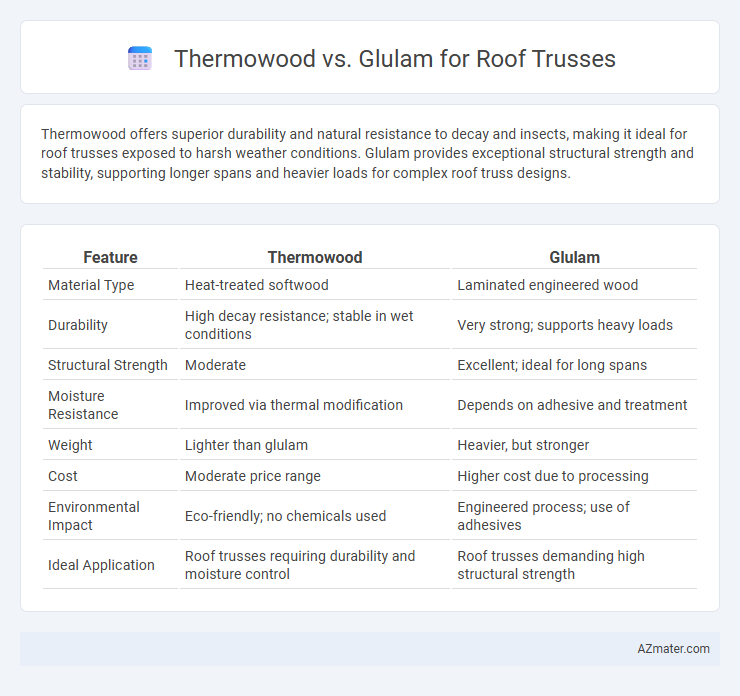Thermowood offers superior durability and natural resistance to decay and insects, making it ideal for roof trusses exposed to harsh weather conditions. Glulam provides exceptional structural strength and stability, supporting longer spans and heavier loads for complex roof truss designs.
Table of Comparison
| Feature | Thermowood | Glulam |
|---|---|---|
| Material Type | Heat-treated softwood | Laminated engineered wood |
| Durability | High decay resistance; stable in wet conditions | Very strong; supports heavy loads |
| Structural Strength | Moderate | Excellent; ideal for long spans |
| Moisture Resistance | Improved via thermal modification | Depends on adhesive and treatment |
| Weight | Lighter than glulam | Heavier, but stronger |
| Cost | Moderate price range | Higher cost due to processing |
| Environmental Impact | Eco-friendly; no chemicals used | Engineered process; use of adhesives |
| Ideal Application | Roof trusses requiring durability and moisture control | Roof trusses demanding high structural strength |
Introduction to Thermowood and Glulam
Thermowood is a type of wood that has been heat-treated to enhance its durability, stability, and resistance to decay, making it ideal for roof truss applications exposed to varying weather conditions. Glulam, or glued laminated timber, consists of multiple layers of wood bonded with strong adhesives, providing superior structural strength and flexibility for complex roof designs. Both Thermowood and Glulam offer distinct advantages, with Thermowood excelling in natural resistance and Glulam delivering engineered strength for long-span roof trusses.
Key Material Properties Compared
Thermowood offers enhanced durability and dimensional stability due to its heat treatment process, which reduces moisture content and increases resistance to decay and insects, making it ideal for outdoor applications like roof trusses. Glulam, engineered by laminating multiple wood layers with adhesives, provides superior structural strength and flexibility, allowing longer spans and heavier loads in roof construction. Both materials excel in sustainability, but Thermowood focuses on natural wood enhancement, while Glulam emphasizes engineered performance and load-bearing capacity.
Durability and Weather Resistance
Thermowood offers superior durability and weather resistance due to its thermal modification process, which enhances stability and reduces moisture absorption, making it highly resistant to decay and insect attacks in roof truss applications. Glulam, while strong and capable of bearing heavy loads, relies on adhesive resins that can be vulnerable to prolonged exposure to moisture unless properly sealed and maintained. For long-term roof truss performance in harsh weather conditions, Thermowood provides a more resilient option with better resistance to environmental factors.
Strength and Structural Performance
Thermowood offers enhanced durability and dimensional stability due to its heat treatment process, making it highly resistant to moisture and decay, which is beneficial for roof truss longevity. Glulam, or glued laminated timber, provides superior structural strength and load-bearing capacity because of its engineered layers, allowing for longer spans and heavier loads in roof truss applications. While Thermowood excels in environmental resistance, Glulam outperforms in terms of maximum strength and flexibility, making the choice dependent on specific structural requirements and environmental conditions.
Sustainability and Environmental Impact
Thermowood offers enhanced durability through a heat treatment process that eliminates chemicals, making it an eco-friendly choice with reduced environmental impact for roof trusses. Glulam, produced from engineered timber layers bonded with adhesives, provides high structural strength while promoting sustainable forestry practices due to its efficient use of timber resources. Both materials contribute to sustainable construction, but Thermowood's chemical-free treatment and longer lifespan offer a lower carbon footprint compared to traditional glulam adhesives.
Aesthetic Appeal and Design Flexibility
Thermowood offers a rich, warm aesthetic with natural texture variations, enhancing visual appeal in roof truss designs, while its stability allows for creative shapes and curved elements. Glulam provides superior strength and uniformity, enabling long spans and complex architectural forms with a sleek, engineered finish suited for modern, precise designs. Both materials support diverse design flexibility, but Thermowood excels in rustic, natural looks whereas Glulam is preferred for contemporary, structural elegance in roof trusses.
Installation and Workability
Thermowood offers enhanced dimensional stability and resistance to moisture, simplifying installation by reducing the risk of warping or shrinking during assembly. Glulam's engineered layers provide consistent strength and predictability, facilitating precise cutting and joining in complex roof truss designs. Both materials accommodate standard fastening methods, but Thermowood's natural wood properties improve workability in variable weather conditions.
Maintenance Requirements
Thermowood offers superior resistance to decay and insect damage, resulting in lower maintenance requirements compared to conventional wood used in roof trusses. Glulam, while structurally strong and versatile, may require periodic inspection for moisture intrusion and protective treatments to prevent delamination and fungal growth. Choosing Thermowood reduces long-term upkeep costs and extends the lifespan of roof truss components in various environmental conditions.
Cost Analysis and Long-Term Value
Thermowood offers moderate upfront costs with enhanced durability due to its thermal modification process, reducing maintenance expenses over time compared to traditional wood. Glulam trusses, while generally more expensive initially due to engineered layering and gluing techniques, provide superior load-bearing capacity and long-term structural stability, often translating into lower replacement and repair costs. Evaluating total lifecycle expenses reveals that Thermowood is cost-effective for projects prioritizing sustainability and moderate strength, whereas Glulam delivers greater long-term value in high-load, demanding roof truss applications.
Choosing the Right Material for Your Roof Truss
Thermowood offers superior durability and resistance to decay due to its heat-treated process, making it ideal for roof trusses in humid or harsh environments. Glulam, engineered from multiple layers of laminated timber, provides exceptional strength and design flexibility, supporting longer spans and heavier loads. Selecting between Thermowood and Glulam depends on factors such as structural requirements, environmental conditions, and budget constraints to ensure optimal performance and longevity.

Infographic: Thermowood vs Glulam for Roof Truss
 azmater.com
azmater.com